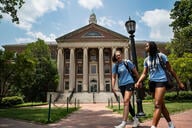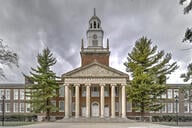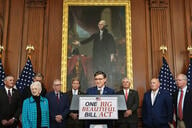You have /5 articles left.
Sign up for a free account or log in.
Students at a community college in rural Texas may lose access to federal aid because of a student-loan default measure Congress expanded mostly to keep an eye on for-profit institutions.
Frank Phillips College is among several two-year colleges whose leaders are worried about how their institutions will fare with this fall’s release of the first batch of sanction-bearing numbers under the revised federal-loan default rate.
“We’ve done everything we can,” said Jud Hicks, the president of Frank Phillips, which is located in the Texas panhandle. “We understand the consequences.”
The U.S. Department of Education now tracks defaults among federal loan recipients for three years after they leave college. Two-year rates had previously been the standard. But the U.S. Congress inserted the expanded “cohort default rates” into the 2008 reauthorization of the Higher Education Act, which is the law that governs federal financial aid.
Student advocates had pushed for the three-year rates. They argued that the new measure would do a better job of gauging students' indebtedness and the value of the education they received.
Default rates are higher under the expanded rates, particularly among for-profits.
For example, last year’s release, which was based on loan repayments that were due in 2011, showed an average default rate of 21.8 percent in the for-profit sector, compared to 13.6 under the two-year metric. The three-year rate was 13 percent at all public institutions (including four-year institutions) and 8.3 percent at private, nonprofit institutions. Two-year rates were 9.6 at publics and 5.2 percent at privates.
Sanctions will kick in with this year’s release of three-year rates. (No penalties applied to the results of the first two years of data.)
Colleges will lose eligibility for all federal aid, including the Pell Grant program, if their rates top 30 percent for three consecutive years or 40 percent for a single year.
Relatively few institutions would fail under these rates, said Jacob P.K. Gross, an assistant professor of education at the University of Louisville, who has written about default rates. According to an analysis he conducted of data from the first two releases, 218 institutions went above 30 percent at one point and 37 -- or 4.3 percent of all institutions participating in federal aid programs -- failed to stay below 40 percent.
The rates set “very low thresholds,” Gross said. “We’re not really talking about so many institutions.”
Sliding Scale for Penalties
High default rates are a concern in all sectors, according to lawmakers, student advocates and college leaders. But most thought community colleges would be in the clear thanks to their relatively affordable tuition, which results in small numbers of student borrowers. That confidence appears to be somewhat misplaced, at least in the case of Frank Phillips.
Some community college officials said default rates penalize colleges for factors beyond their control, such as the local economy or the life circumstances of students. And colleges can do little to encourage students not to take on unnecessary debt.
The law includes a protection for institutions that face default-rate sanctions. Colleges can file an appeal with the department based on the proportion of students who take out federal loans. The appeal was built into the law to prevent colleges from being punished based on a small number of borrowers.
The federal “participation rate index challenge” creates a sliding scale. Put simply, it sets a standard for sanctions that is more lenient if a smaller percentage of an institution’s students take out loans.
For example, the baseline default rate of 30 percent carries penalties only at institutions where at least 21 percent (roughly) of students participate in federal loan programs. But if a college has a higher default rate, it could trigger sanctions even if fewer students participate; a college would face penalties for a default rate of 35 percent if its participation rate was at least 18 percent, for instance.
Since only 19 percent of all community college students borrow, according to data from the American Association of Community Colleges, the sectorwide three-year default rate of 21 percent means few would fail under the appeal process.
But while most community colleges with failing rates will prevail with their appeals, experts said, they will still take a public-relations hit when the statistics are released.
To help correct this problem, the Institute for College Access and Success (TICAS) has pushed the department to publish borrowing rates along with default rates. Debbie Cochrane, the institute’s research director, said the feds could also send a clearer message by allowing colleges to appeal on an annual basis, rather than just after failing for three consecutive years.
Jee Hang Lee, vice president for public policy and external relations at the Association of Community College Trustees, agreed that an annual challenge process makes sense. He also said the department could do more to help colleges get the word out about income-based repayment options.
Frank Phillips College, however, likely will be unable to succeed in an appeal, Hicks said. Colleges received a draft version of their fall rate in February. And the small Frank Phillips, which enrolls 1,200 students, faces a third straight year of topping 30 percent in defaults.
That’s not for a lack of trying, said Hicks. The college brought in a default management consultant and has worked with students to help them repay their loans, such as through informing them of repayment, deferment or forbearance options. But the sagging local economy is a major factor.
Frank Phillips isn’t the only rural community college that is struggling with relatively high default rates, several experts said. That’s because rural areas are less likely to have bounced back from the recession.
Just a few more loan-repaying students could have put Frank Phillips over the hump. The college would not be facing sanctions if just four defaulters had been able to repay their loans in a recent year.
In a December letter Hicks sent to Arne Duncan, the secretary of education, he said the college was facing “unintended consequences” from the loan default policy. Hicks also said the process did not give the college an adequate opportunity to reduce its rates.
Far more students at Frank Phillips receive Pell Grants (461 this year) than take out federal loans (193), according to Hicks. Only 38 students participate in both programs. Yet it appears likely that all federal aid will be out of reach for the college’s many lower-income students.
“It seems somewhat punitive for an institution to lose Pell because of a loan default issue,” Hicks said via email. “From a student participation perspective, these are unrelated.”
Hicks said the college is working with department officials to double-check its default numbers.
Preemptive Jump
Several community colleges around the country have pulled out of federal lending programs voluntarily. They cite the risk of default-rate penalties and a desire to preserve student access to other forms of federal aid.
For example, less than half of North Carolina’s community colleges are participating in federal loan programs. Central Piedmont Community College made the decision to drop loans last month.
Roughly 9 percent of community college students nationwide are not able to access federal loans, according to 2011 data; the number has likely gone up since then.
The Education Department has urged colleges not to jump. In a February “Dear Colleague” letter the department explained the rules on default rates and appeals, and also noted the “importance of institutions providing continued student access to the Title IV student loan programs.”
TICAS has blasted colleges for deciding to pull out of lending. They say some, such as Victor Valley College, which is located in California, made the decision without apparently being aware of participation-rate appeals and protections. The department deserves some of the blame, according to TICAS, which says the agency can do more to explain options to institutions.
However, Cochrane said some community colleges appear unwilling to accept that their rising tuition rates are not as affordable as they once were.
“There’s still somewhat of a tepid embrace of federal loans” among community college leaders, she said.
The two community college associations have been pushing hard in Washington for more flexibility on default rates among their members. For example, AACC wants Congress to decouple eligibility for Pell Grants from that of federal loans when it reconsiders the Higher Education Act.
“It’s bad public policy for community colleges to lose their Pell Grant eligibility because former students have not repaid their loans,” said David Baime, the association’s senior vice president for government relations and research.
Cochrane, however, wasn’t sold. She said such a move “does nothing but accept colleges' ability to evade accountability.”




